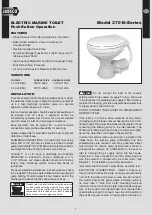
3
If the toilet is plumbed to an overboard discharge, and is
below the vessel’s waterline, the discharge plumbing
must include a properly positioned vented loop. The
vented loop fitting must be secured in a location that
remains at least 6-8 inches (15-20 cm) above the
waterline at all angles of heel and trim. The maximum
discharge head without a notable decrease in pump per-
formance is four feet (1.3 M).
Ensure each hose end is pushed completely onto its port
fitting and secure each with a hose clamp. All hose con-
nections made below the waterline should be secured
with two stainless steel band clamps. It is best to secure
the hoses in place about every eighteen inches along
the length of the run.
Once all hose connections are completed and secured
with clamps, it is best to complete the wiring so the toilet
can be tested for leaks prior to fastening it to its mount-
ing surface. Once the electrical wiring is complete, test
the toilet by flushing several times and blot all hose ter-
mination’s completely around each connection with a
white paper towel and inspect the towel for wet spots. If
the towel comes away dry from each connection within
the china bowl, proceed to fasten the toilet to its mount-
ing surface.
Position the toilet in its intended mounting position and
very gently, with a 10 mm wrench, screw the provided
toilet hold-down fastener into the pilot hole drilled earlier.
Do not overtighten these fasteners as this may crack the
china. It is only necessary to make the fasteners snug
enough to prevent the toilet from sliding around. Screw
the dress cap into the top of the hold-down screw.
Flood hazard. If toilet is installed below the
waterline or may be below the waterline at any
angle of heel or trim, it must be installed with
properly positioned vented loops. Failure to do
so can result in flooding which can cause loss
of property and life.
WARNING
!

















